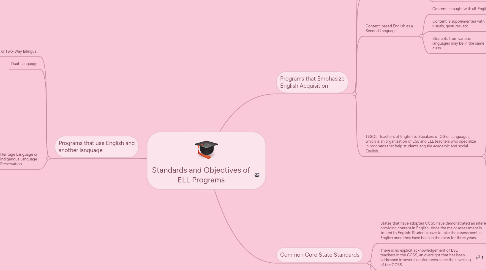
1. Programs that use English and another language
1.1. Two-Way Immersion or Two-Way Bilingual
1.2. Dual-Language
1.3. Heritage Language or Indigenous Language Preservation
1.3.1. Goal is literacy in both languages
1.3.2. Teachers must be fluent in both languages
1.3.3. Indigenous Language Program
1.3.4. Native Pathways to Language Acquisition are based on the idea that both native and western ideas can contribute to a more complete education for indigenous students. By becoming more comfortable with traditional languages and culture, students will be even more adept at acquiring Western educational skills.
1.3.5. This program is particularly valuable for endangered languages; it helps to preserve native languages while also giving students desirable skills and the ability to succeed in a 21st century economy.
1.3.6. The Alaska Native Knowledge Network emphasizes both the importance of native Alaskan languages and the cultural heritage of indigenous Alaskan tribes, while still making sure indigenous students are exposed to Western American experiences and opportunities.
2. Programs that Emphasize English Acquisition
2.1. English Language Development
2.1.1. Goal is fluency in English
2.1.2. Students get pull-out support in social English, until they can be successful in a classrom
2.1.3. There is little native language support
2.2. Structured English Immersion
2.2.1. All instruction is in English
2.2.2. Teachers need receptive skills in L1
2.3. Content-based English as a Second Language
2.3.1. Content is taught with all-English
2.3.2. Content is supplemented with visuals, gestures, etc.
2.3.3. Students from various languages may be in the same class
2.4. TESOL: Teachers of English to Speakers of Other Languages, which is an organization of ESL and ELL teachers who specialize in programs that help students acquire academic and social English.
2.4.1. TESOL offers a variety of tools and methods to help with at the acquisition of English.
2.4.2. TESOL also allows for different methods and methodology, but employs complex systems allowing teachers to track their students progress in English across five standards
2.4.2.1. Standard 1: English language learners communicate for social, intercultural, and instructional purposes within the school setting.
2.4.2.2. Standard 2: English language learners communicate information, ideas, and concepts necessary for academic success in the area of language arts.
2.4.2.3. Standard 3: English language learners communicate information, ideas, and concepts necessary for academic success in the area of mathematics.
2.4.2.4. Standard 4: English language learners communicate information, ideas, and concepts necessary for academic success in the area of science.
2.4.2.5. Standard 5: English language learners communicate information, ideas, and concepts necessary for academic success in the area of social studies.
2.4.3. TESOL includes pull-out for students to help develop their specific needs in English; this can be an effective tool, since one-on-one time is so essential for language acquisition.
